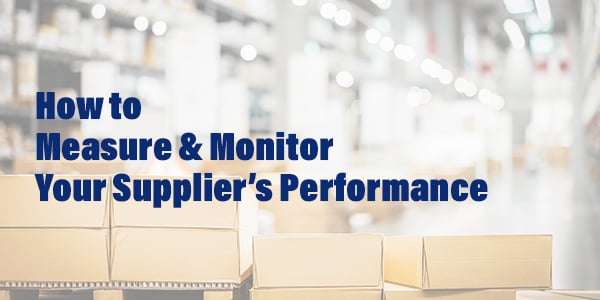
Everyone is familiar with the KISS principle, and while “keeping it simple” works well with just about everything, it is especially true for supplier performance measurement. Supplier performance measurement evaluates supplier performance against set parameters to achieve the highest level of reliability, quality, and performance while limiting risk. The tool monitors whether suppliers perform their work as agreed in your contract, statement of work, specification, service level agreement, or KPIs. The more complicated the KPI, the more you’ll struggle to wrangle your data.
Some examples of supplier performance measures include:
- Timelines: Are your goods delivered on time or services rendered within a set timeframe?
- Delivery in Full: Did the supplier complete the delivery or service within the expected duration and with the expected outcome?
- Quality: Does your supplier perform the work without defects or unplanned failures that lead to reworks, errors, or complaints?
- Regulatory Compliance: Does the supplier work within Customs mandates, health and safety protocols, or organizational guidelines?
Make Goals SMART
The best supplier performance measures are SMART, an acronym that stands for:
- Specific—Goals are clearly defined.
- Measurable—Develop criteria to measure goals against.
- Action-oriented—Define clear actions to achieve a goal.
- Realistic—Set goals that are attainable and reasonable.
- Time-based—Give suppliers a definite deadline.
Following the SMART principle creates realistic goals that produce specific outcomes. You don’t want big, unattainable objectives that discourage suppliers. You want to set achievable goals that deliver practical results. The process is not meant to be daunting or overwhelming.
If receiving goods on time is your goal, then set a KPI for on-time delivery 98% of the time. After all, your customers hold you to similar limits. You may also set a goal that requires your supplier to communicate shipment status in real-time along that line. Armed with this information, you can update your customer when shipments arrive early or late.
Limit the Number of Goals
Consider goals carefully and set goals that track the most important criteria for your operation. It’s unnecessary to set and measure 20 KPIs just because you can. Drowning in data leaves little time for analysis, which is essential to understanding supplier performance.
Create a list of possible KPIs, then pick those that matter most to your business. Begin measuring supplier performance against KPIs of critical importance and move down your list toward supplementary goals.
Remember to keep your results in a central database that is accessible by stakeholders across your organization. The data lets you track supplier performance over time and helps with decision-making. The data shows when suppliers achieve set goals and alerts you when their performance deteriorates.
One Size Doesn’t Fit All
Just as every supplier is different, the standards against which you measure suppliers should be as well. Holding every supplier to the same performance standard fails to recognize their unique differences.
Measuring on-time delivery for a supplier that’s never late makes little sense. Maybe the supplier is always on time, but repeated errors lead to reworks, errors, or complaints. Here, a KPI measuring quality is more applicable.
Write a clear objective KPI tailored to the specific supplier. Measures and targets should be specific to your development goals for that vendor. Perhaps you want your supplier to grow their capacity to manage your company’s growing demand. Or maybe you want a supplier struggling with timely deliveries to improve on-time delivery.
Once you have a clear objective KPI, share it with your supplier. Performance measures are useless if you do not share them with others. Explain why you measure what you do and answer all questions. And be sure to solicit supplier input. When KPIs lack supplier input and support, they become difficult to achieve. You achieve better results when you have a consensus around what’s being measured.
Don’t forget to measure the overall success of your relationship with each supplier. Consider account responsiveness and communication, data sharing, and other parameters.
Standardize Measurements
Though KPIs may differ from one supplier to the next, monitoring performance measures should be the same. Standard measures allow apples-to-apples comparisons between suppliers.
A good standard measurement system allows you to set supplier-specific targets while measuring and reporting performance the same way. It compares performance against price, cost, and other external benchmarks. It also simplifies reporting within the organization, as well as with other stakeholders.
Make sure that the standard measurements allow for flexibility. You may want to adjust payment terms to reward good performance or ensure your contract includes penalties for poor performance. Or maybe you want suppliers to give input into performance measures. Both approaches are impossible without a flexible system.
Use digital tools that measure goals against actual performance and keep records in a central repository to help standardize supplier performance across a range of KPIs, shipments, and geographies.
Measure Performance Regularly
Do not set KPIs to measure supplier performance, only to forget about them later. The best supplier performance measurement programs analyze performance regularly.
Most companies measure supplier performance quarterly, others annually. Whatever timeframe you choose, it’s important to do it regularly and share your insights with your suppliers. These reviews help track trends, adjust targets, or add new goals for continuous improvement. Process improvements only happen when every stakeholder understands the KPIs and how their performance stacks up.
A robust KPI measurement program improves supplier performance and generates ideas for continuous improvement. It can lower your risks and streamline administrative tasks while revealing problems so you can address them quickly.



